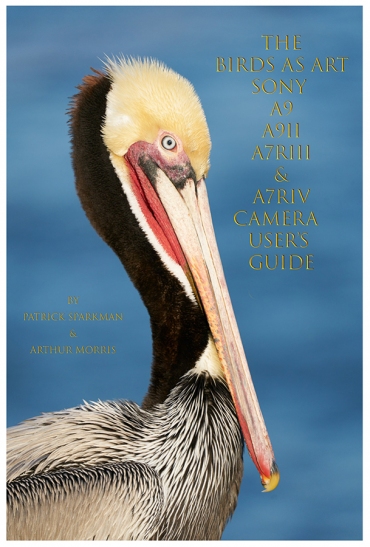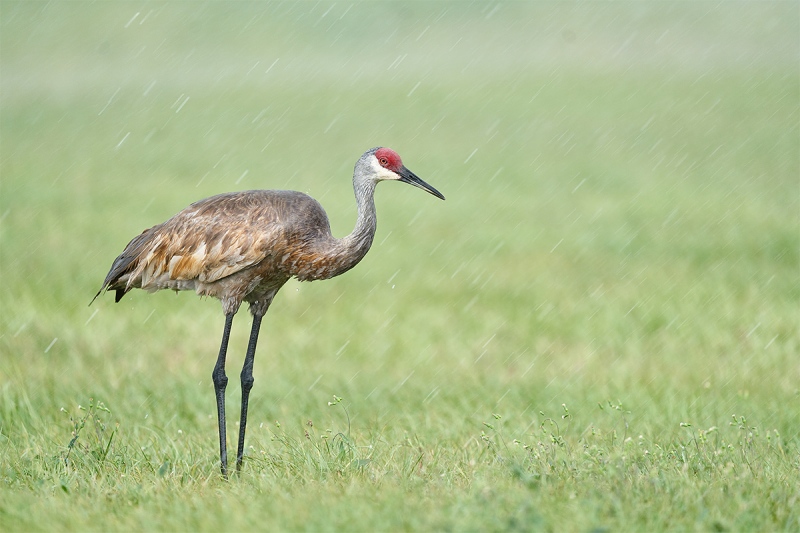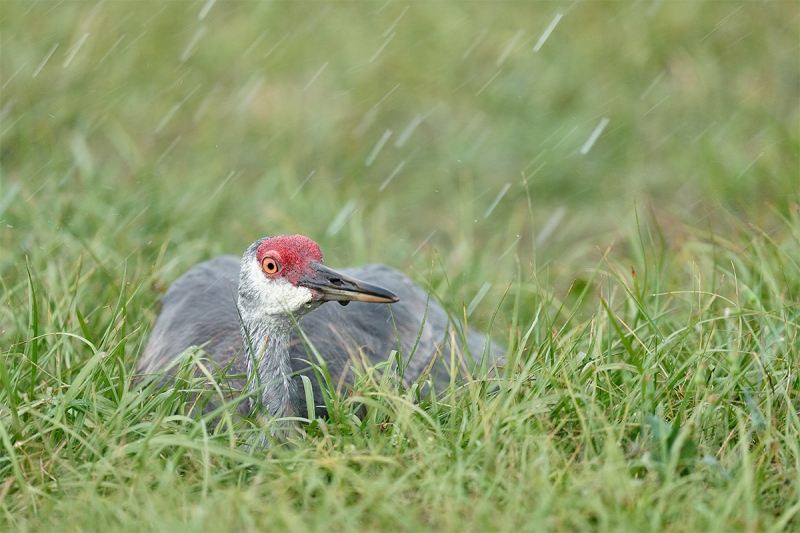What’s Up?
I began Friday morning with the dependable and tame crane chicks in early light but nothing great. By 8:00am it was cloudy-bright and still so I did some flowers. My macro plan is not working out too well; details soon. Friday afternoon marked two days in a row with thunderstorms but the rain was not as heavy as it was on Thursday (as seen in today’s two featured images. Speaking of which, do let us know which of the two images you feel is the stronger image and why.
There was another big mayfly hatch on Friday. The cranes were chowing down along with several 20-30 bird flocks of White Ibises and a few Great and Cattle Egrets.
Activity on the Used Gear Page continues to increase with many sales and pending sales (including five of Anita North’s NIKKOR lenses and Sandra Calderbank’s Canon 400mm f/2.8L IS II, all for BAA record-low prices). See the great Nikon Firesale listings here.
Free Sandhill Crane Chick Grass Blade Removal Video Offer
Those who purchase the BIRDS AS ART Current Workflow e-Guide (Digital Basics II) this weekend will automatically receive a free copy of the Sandhill Crane Chick Grass Blade Removal Video.
BIRDS AS ART
BIRDS AS ART is registered in the U.S. Patent and Trademark Office.
|
|
|
70 sold with rave reviews. The SONY e-Guide by Patrick Sparkman and Arthur Morris |
The Sony Camera User’s e-Guide (and Videos)
Click here to purchase the guide with one Camera Set-up Video. Be sure to e-mail us by clicking here to specify your camera body so that we can send you a link for the correct video.
Click here to purchase the guide with two Camera Set-up Videos. Be sure to e-mail us by clicking here to specify your two camera bodies so that we can send you links for the correct videos.
Click here to learn more about the SONY e-Guide.
SONY 200-600 Update
Steve Elkins now has four SONY 200-600s in stock; one of them surely has your name on it. Contact Steve as below to save $50.00.
Money Saving Reminder
If you need a hot photo item that is out of stock at B&H, would enjoy free overnight shipping, and would like a $50 discount on your first purchase over $1000.00, click here to order and enter the coupon code BIRDSASART at checkout. If you are looking to strike a deal on Canon or Nikon gear (including the big telephotos) or on a multiple item order, contact Steve Elkins via e-mail or on his cell at (479) 381-2592 (Eastern time) and be sure to mention your BIRDSASART coupon code and use it for your online order. Steve has been great at getting folks the hot items that are out of stock at B&H. Those include the SONY a7r IV, the SONY 200-600, the SONY 600mm f/4 GM, and the Nikon 500mm PF. Steve is eager to please.


Gear Questions and Advice
Too many folks attending BAA IPTs and dozens of photographers whom I see in the field and on BPN, are–out of ignorance–using the wrong gear especially when it comes to tripods and more especially, tripod heads… Please know that I am always glad to answer your gear questions via e-mail. Those questions might deal with systems, camera bodies, accessories, and/or lens choices and decisions.
|
|
|
This image was created on 21 MAY 2020 at Indian Lake Estates, FL. Working from the driver’s seat of my SUV, I used the FlexShooter Mini-mounted Sony FE 600mm f/4 GM OSS lens and the 61-MP Sony Alpha a7R IV Mirrorless Digital Camera Body. ISO 640. Exposure determined by Zebras with ISO on the rear dial: 1/250 sec. at f/4 in Manual mode. AWB at 6:19pm during a thunderstorm. Tracking Flexible Spot (S) AF-C was active at the moment of exposure and performed quite well. Click on the image to see a larger version. Image #1: Sandhill Crane, adult standing in heavy rain |
Photographing Birds in Heavy Downpours During Thunderstorms
I love photographing birds in heavy downpours during thunderstorms. But I pretty much hate the lens raincoats. I have tried the most expensive (complex) ones and the simple ones and find them all cumbersome and difficult to use. On a Southern Oceans trip about ten years ago I trashed two Canon EOS-1D Mark IV bodies during a heavy downpour somewhere on South Georgia. I will still photograph on foot in a heavy drizzle but not in a big storm with heavy rain. When it is raining lightly and I am away from my vehicle I will simply place a woolen watch cap over my camera and peek under it to make some images. I have never had a lens damaged by rain no matter how torrential.
When I lived in Deltona I did lots of photography at Gatorland. Now? Not so much. I cannot remember the last time I was up there. IAC, when there was a chance for an afternoon thunderstorm I would bring a large golf umbrella, an Umbrella Clamp Rig, and my flash stuff. What fun. I never owned a Nikon flash and I do not own a SONY flash. The only times I miss not having a flash are when I am photographing strongly backlit/rim-lit subjects and when shooting in the rain (when the flash makes the raindrops no the subject sparkle!)
Learn how to photograph in a driving rainstorm by scrolling down to the item next.
|
|
|
This image was also created on 21 MAY 2020 at Indian Lake Estates, FL. Still working from the driver’s seat of my SUV, I used the FlexShooter Mini-mounted Sony FE 600mm f/4 GM OSS lens and the 61-MP Sony Alpha a7R IV Mirrorless Digital Camera Body. ISO 1250. Exposure determined by Zebras with ISO on the rear dial: 1/320 sec. at f/4 in Manual mode. AWB at 6:22pm during a thunderstorm. Tracking Flexible Spot (S) AF-C was active at the moment of exposure and performed quite well. Click on the image to see a larger version. Image #2: Sandhill Crane brooding two chicks during rainstorm |
Working From Your Vehicle in Heavy Downpours During Thunderstorms
In central Florida, you pretty much know that when the wind picks up a thunderstorm is likely to follow. That and the blackening skies. Working from your vehicle keeps your gear dry for the most part, and offers protection from lightning. The trick is to angle your vehicle so that the wind is blowing at the passenger side (with those windows shut of course). That places you in the lee so that you and your gear stays dry. 99% of the time I will be using a big f/4 lens on a tripod set up inside my SUV (or car). Why are fast lens so valuable in a rainstorm? The extra stop or more of light saves you three or four clicks of ISO when the skies are dark and the light is low.
There was a nasty GREEN cast in the feathers of the bird’s chin. I selected those feathers with the Lasso Tool and reduced the Saturation 45 points. Voila!
As far as shutter speed when it is raining, I have found that intermediate shutter speeds in the range of from 1/200 to 1/400 sec. will usually produce pleasing rain streaks with not-too-distant subjects. Do you prefer the rain streaks in Image #1 or the rain streaks in Image #2?
Despite the faster shutter speed with Image #2, why might the rain streaks be larger and more obvious in Image #2 than in Image #1. Me-thinks there are two reasons …
|
|
The BIRDS AS ART Current Workflow e-Guide (Digital Basics II).You can order your copy from the BAA Online Store here, by sending a Paypal for $40 here, or by calling Jim or Jennifer weekdays at 863-692-0906 with your credit card in hand. |
The BIRDS AS ART Current Workflow e-Guide (Digital Basics II)
Several ways of dealing with color casts — along with all of my personalized Keyboard Shortcuts and dozens of great Photoshop tips and techniques, are detailed in the BIRDS AS ART Current Workflow e-Guide (Digital Basics II), an instructional PDF that is sent via e-mail. Learn more and check out the free excerpt in the blog post here. While the new e-Guide reflects my Macbook Pro/Photo Mechanic/DPP 4/Photoshop workflow, folks using a PC and/or BreezeBrowser will also benefit greatly by studying the material on DB II. Note: folks working on a PC and/or those who do not want to miss anything Photoshop may wish to purchase the original Digital Basics along with DB II while saving $15 by clicking here to buy the DB Bundle.
Folks who learn well by following along rather than by reading can check out the complete collection of MP 4 Photoshop Tutorial Videos by clicking here. Note: all of the videos are now priced at an amazingly low $5.00 each.
You can learn how and why I converted all of my Canon digital RAW files in DPP 4 in the DPP 4 RAW Conversion Guide here. More recently, I became proficient at converting my Nikon RAW (NEF) files in Adobe Camera Raw. About two years ago I began converting my Nikon and Sony RAW files in Capture One Pro 12 and continue to do so today.
To purchase Capture One, please use this link. Then you can learn more about Capture One in the Capture One Pro 12 Simplified MP4 Video here. The next step would be to get a copy of Arash Hazeghi’s “The Nikon Photographers’ Guide to Phase One Capture One Pro e-Guide” in the blog post here.
You can learn advanced Quick Masking and advanced Layer Masking techniques in APTATS I & II. You can save $15 by purchasing the pair. Folks can learn sophisticated sharpening and (NeatImage) Noise Reduction techniques in The Professional Post Processing Guide by Arash Hazeghi and edited by yours truly. Please use this link to purchase NeatImage.
To introduce folks to our MP.4 videos and the basics involved in applying more NeatImage noise reduction to the background and less on the subject, I’d be glad to send you a free copy of the Free Noise Reduction Basics MP.4 Video. Simply click to shoot me an e-mail to get your free copy.
If In Doubt …
If you are in doubt about using the BAA B&H affiliate link correctly, you can always start your search by clicking here. Please note that the tracking is invisible. Web orders only. Please, however, remember to shoot me your receipt via e-mail.






Please Remember to use my Affiliate Links and to Visit the BAA Online Store 🙂
To show your appreciation for my continuing efforts here, we ask, as always, that you get in the habit of using my B&H affiliate links on the right side of the blog or Bedfords, for all of your photo and electronics purchases. Please check the availability of all photographic accessories in the New BIRDS AS ART Online Store, especially the Mongoose M3.6 tripod head, Wimberley lens plates, Delkin flash cards and accessories, and LensCoat stuff.
As always, we sell only what I have used, have tested, and can depend on. We will not sell you junk. We know what you need to make creating great images easy and fun. And please remember that I am always glad to answer your gear questions via e-mail.
I would, of course, appreciate your using our B&H affiliate links or Bedfords for all of your major gear, video, and electronic purchases. For the photographic stuff mentioned in the paragraph above, and for everything else in the new store, we, meaning BAA, would of course greatly appreciate your business. Here is a huge thank you to the many who have been using our links on a regular basis and those who regularly visit the New BIRDS AS ART Online Store as well.
Be sure to like and follow BAA on Facebook by clicking on the logo link upper right.
Typos
In all blog posts and Bulletins, feel free to e-mail or to leave a comment regarding any typos or errors. Just be right :).



















I like both images a lot. The rain adds that extra dimension. In relation to the birds head, the rain streaks are the same length in both images. In image 1 the closer rain streaks to the bird will be a bit sharper and the rain closer to the camera blurred out. In image 2, by being closer in terms of focal distance you pick up closer rain drops which are a bit more out of focus which makes them wider but not longer.
Really like both but #2 best because of the unusual pose. Believe the rain is more prominent in #2 because you are closer and it is raining harder. Maybe a little more daylight to reflect also.
Because you are closer to bird #2 the raindrops show up larger? I like #2 because the drops show up much better and I like the wild expression of the bird. But with #1 enlarged the rain drops show up well there too. I like the overall haze of drops in #1 when enlarged.
No. 2 for me. I like the streaking rain and the pose of the crane with the water on the beak. The streaks are larger because the rain is falling and you raised the ISO approximately 1 full stop that made the rain more prominent by adding some noise.
I like #2. Closer, or cropped more (?). Either way, it holds up well. I like the drip of water on the beak in #2. Also like the feather detail in #1. Pretty much hammered the exposure on both.
Rain streaks may appear longer due to being, or appearing to be, closer to the lens. Since the focal lengths did not change, the closer image will benefit more (in size) by being larger in the frame, as will the raindrop streaks.
I do like both images. I’d be happy to call either one mine.
10-15 bald eagles feeding at Seabeck yesterday, but cloudy, dark cloudy.
Thanks, and be well out there.
Image # 1 is my favourite, I like the finer streaks of rain in #1. I like the shallow depth of field in #1, the way it shows the row of in focus grasses across the entire frame. I like the way she/he appears to be leaning into the wind and rain. I also like how the dark colour of the wet bird stands out against the soft pastel colour of the background.
Well said.
with love, a
ps: I love the tiny blossoms in the area of sharpest focus!
Hey Arthur, Love a bird in the rain. The rain was harder and the background is darker in image #2.
Me too. I believe that you are 50% correct …
with love, artie